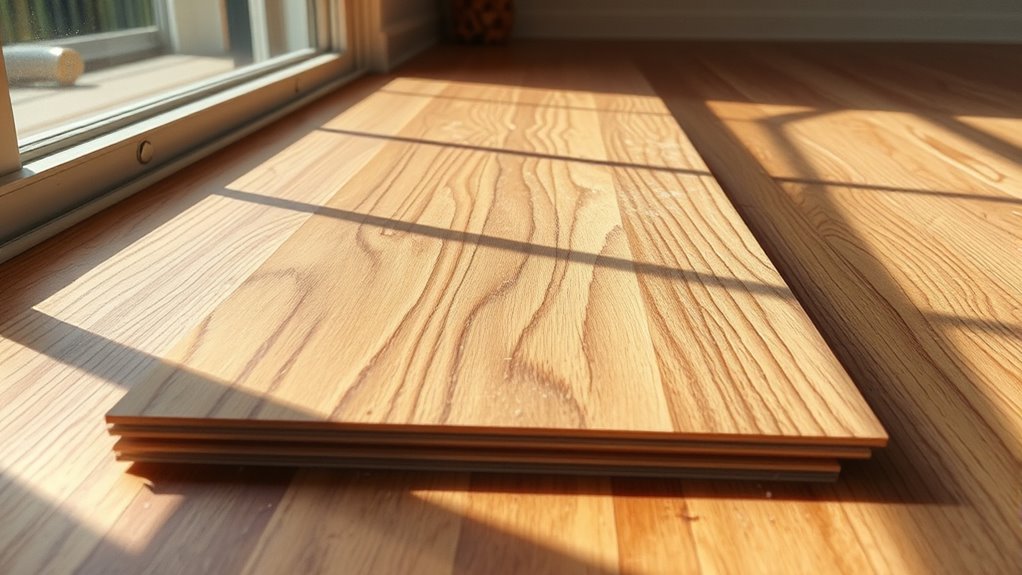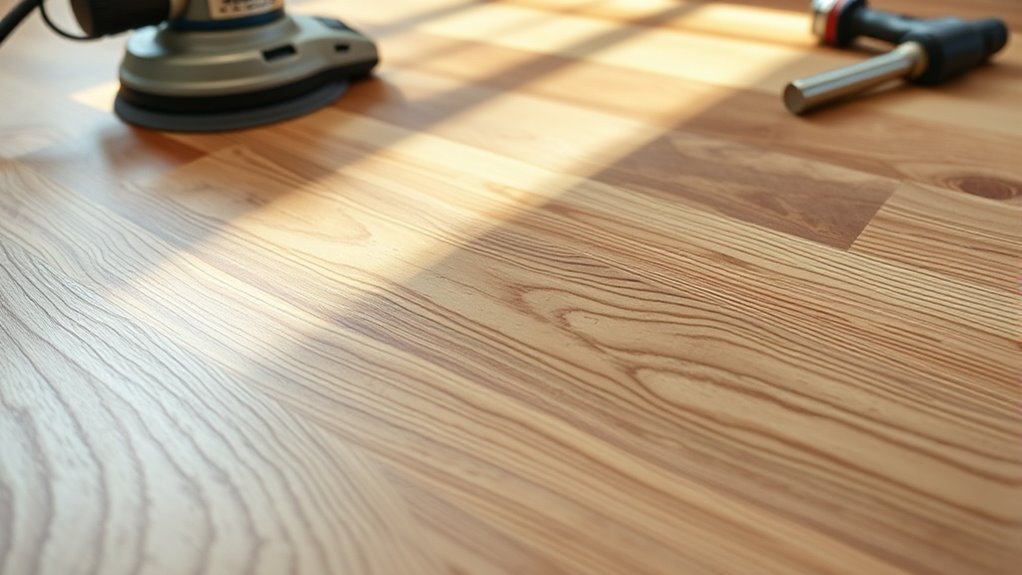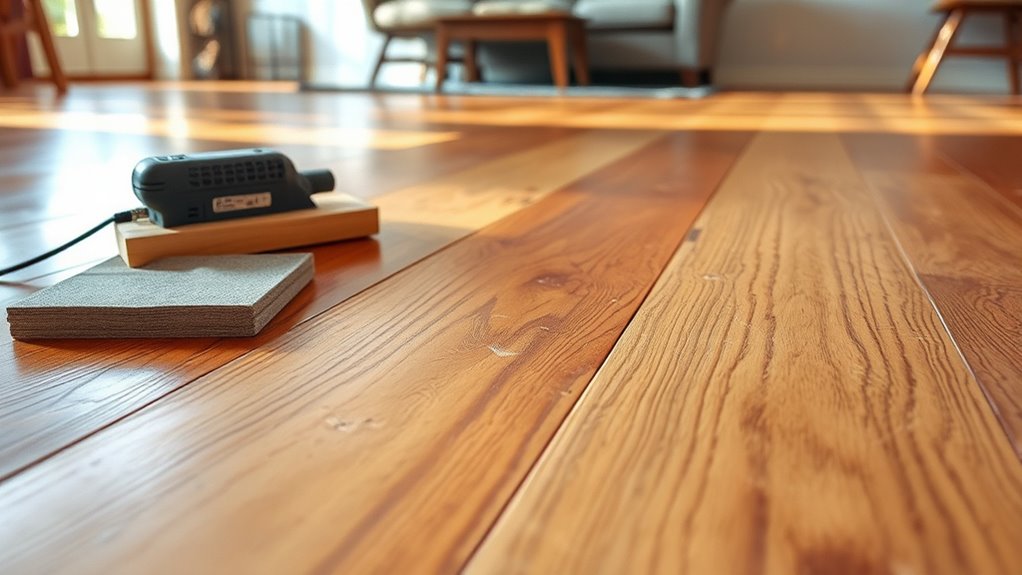You can sand and refinish engineered hardwood floors, but it depends largely on the thickness of the hardwood veneer on top. Thicker veneers (typically 2-4mm) allow more sanding, while thinner layers require careful, light sanding or alternative methods like chemical refinishing to avoid damage. Proper preparation and evaluating wear layer condition are essential before refinishing. To maintain durability and appearance, specific techniques and maintenance best practices should be followed, which are detailed further ahead.
Understanding the Structure of Engineered Hardwood Floors

Engineered hardwood floors consist of multiple layers designed to provide stability and durability. You’ll find a top layer of real hardwood veneer, which offers the authentic look and feel, bonded to several underlying plywood or high-density fiberboard layers arranged in a cross-grain pattern. This engineered construction enhances flooring durability by minimizing expansion and contraction due to humidity and temperature changes. Unlike solid hardwood, which can warp or cup, engineered floors maintain dimensional stability, granting you the freedom to install them in diverse environments, including basements and over radiant heating. Understanding this layered structure is essential for making informed decisions about maintenance, refinishing, and longevity, ensuring your flooring investment remains both resilient and attractive over time.
Signs Your Engineered Hardwood Needs Refinishing
You’ll want to contemplate refinishing when you notice visible surface wear like scratches or dullness that compromise the finish. Water damage indicators such as warping, cupping, or staining also signal the need for refinishing. Additionally, fading and discoloration caused by UV exposure can reduce the floor’s aesthetic appeal and protection.
Visible Surface Wear
Although engineered hardwood is designed for durability, visible surface wear inevitably develops over time, signaling that refinishing may be necessary. This wear manifests as dullness, scratches, or scuff marks on the finish layer, primarily affecting the protective coatings applied during manufacturing. When these coatings degrade, your floor loses its resistance to abrasion and impact, exposing the wood veneer beneath. If you notice uneven sheen, surface discoloration, or increased susceptibility to damage, it’s a clear indicator that the protective layer has thinned. Addressing visible surface wear promptly through sanding and refinishing restores the floor’s integrity and appearance, extending its lifespan. By maintaining the protective coatings, you preserve both the engineered hardwood’s aesthetic appeal and functional resilience, giving you the freedom to enjoy your space without compromising quality.
Water Damage Indicators
Surface wear isn’t the only sign that your hardwood floors might need refinishing; water damage can be equally detrimental and sometimes more insidious. Water stains are often the first visible indicator, appearing as darkened or discolored patches on the engineered hardwood surface. These stains signal that moisture has penetrated the protective finish, potentially compromising the wood layers beneath. Effective moisture detection involves using specialized meters to assess the subfloor’s relative humidity levels, helping you pinpoint hidden damage before it worsens. If left unaddressed, trapped moisture can cause cupping, warping, or delamination of the layers, necessitating more extensive repairs. Recognizing these water damage indicators early guarantees you maintain your floors’ integrity and freedom from costly replacements. Refinishing can restore both appearance and structural stability when moisture hasn’t irreversibly damaged the core.
Fading and Discoloration
When engineered hardwood floors are exposed to prolonged sunlight or harsh cleaning agents, fading and discoloration often develop, signaling the need for refinishing. You’ll notice uneven color fading and persistent stains that resist stain removal efforts. Addressing these signs promptly restores the floor’s uniformity and protects its surface integrity.
| Cause | Effect |
|---|---|
| Prolonged Sunlight | Uneven color fading |
| Harsh Cleaning Agents | Surface discoloration |
| Inadequate Stain Removal | Visible, persistent stains |
| Worn Protective Finish | Increased vulnerability to damage |
Refinishing remedies color fading by sanding down the top layer and applying new finish, freeing your floors from unsightly discoloration and restoring their natural beauty.
Veneer Thickness and Its Impact on Sanding
When sanding engineered hardwood floors, you need to take into account the veneer thickness, which typically ranges from 1mm to 4mm. This thin top layer limits how many times you can sand without exposing the plywood core beneath. Understanding these limitations helps prevent irreversible damage during refinishing.
Typical Veneer Thickness
Veneer thickness plays a critical role in determining how many times you can sand and refinish engineered hardwood floors. The durability of the veneer directly influences how aggressive your refinishing techniques can be without compromising the floor’s integrity. Thicker veneers offer more sanding potential, granting you greater freedom to restore your flooring multiple times.
| Veneer Thickness (mm) | Typical Refinishes Allowed |
|---|---|
| 0.6 – 1.2 | 1 – 2 |
| 1.3 – 2.5 | 3 – 4 |
| 2.6 – 4.0 | 5 – 6 |
| Over 4.0 | 6+ |
Choosing engineered hardwood with a thicker veneer guarantees better veneer durability and extends the lifespan of your refinishing options.
Sanding Limitations
Understanding the exact thickness of your engineered hardwood’s top layer is essential because it directly limits how much sanding you can safely perform without risking damage. Typically, this veneer ranges from 1/16 to 1/8 inch thick. When applying sanding techniques, you must account for this thin layer; excessive sanding can expose the plywood core, compromising wood durability and your floor’s appearance. Unlike solid hardwood, engineered floors don’t tolerate multiple refinishes. To maintain freedom in refinishing, use gentle sanding methods and minimize depth removal. Carefully assess veneer thickness before refinishing to avoid irreversible damage. Ultimately, knowing these sanding limitations helps you preserve the floor’s integrity while extending its lifespan effectively within the veneer’s constraints.
Refinishing Methods Suitable for Engineered Hardwood

Since engineered hardwood has a thinner wear layer compared to solid wood, you’ll need to choose refinishing methods that minimize material removal while restoring the floor’s appearance. Light sanding techniques, such as using fine-grit sandpaper or screen sanding, are preferred to avoid penetrating the veneer layer. This approach allows you to smooth surface imperfections without compromising the ply structure beneath. Alternatively, employing chemical-based refinishing products can rejuvenate the finish without sanding. These products strip and renew the surface coat, preserving the wood layer. When selecting refinishing products, verify they’re compatible with engineered hardwood finishes to prevent damage. By combining gentle sanding techniques with appropriate refinishing products, you maintain the floor’s structural integrity and extend its aesthetic lifespan, giving you the freedom to refresh your space responsibly.
Preparing Your Floors for Sanding and Refinishing
Before you begin sanding and refinishing, you’ll need to thoroughly clean and inspect your engineered hardwood floors to ensure the best results. Start by removing all furniture and debris to provide unobstructed access. Use a vacuum and damp mop to eliminate dust and dirt, which can interfere with sanding techniques. Carefully examine the floor for any damage, such as deep scratches, gaps, or loose boards; address these issues before proceeding. Proper floor preparation also involves checking the thickness of the wear layer to guarantee it can withstand sanding without exposing the core. Plan your sanding approach based on the floor’s condition and layer depth, selecting appropriate grit progression. Meticulous preparation sets the foundation for a smooth, durable finish and extends your floor’s lifespan.
Maintenance Tips to Extend the Life of Your Floors

Although engineered hardwood floors are designed for durability, proper maintenance is vital to preserve their appearance and structural integrity over time. You’ll want to adopt specific cleaning techniques, such as using a microfiber mop and pH-neutral wood cleaner, to avoid damaging the surface. Avoid excessive water, which can infiltrate seams and cause swelling. Applying protective finishes periodically helps create a barrier against wear, moisture, and UV exposure, extending your floor’s lifespan. Use felt pads under furniture to prevent scratches and minimize direct sun exposure by using blinds or curtains. Regularly inspecting your floors for signs of damage guarantees timely intervention before refinishing becomes necessary. By combining these maintenance strategies, you maintain both the freedom to enjoy your space and the technical longevity of your engineered hardwood floors.




